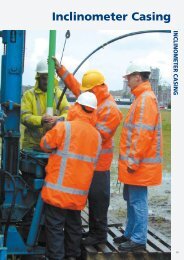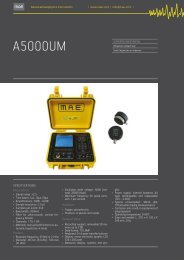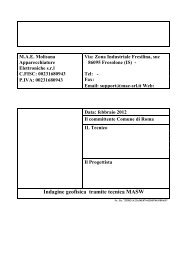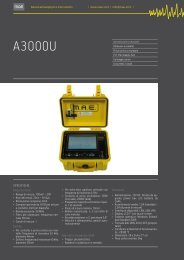Untitled
Untitled
Untitled
Create successful ePaper yourself
Turn your PDF publications into a flip-book with our unique Google optimized e-Paper software.
› Mae 39<br />
SYSMALOG<br />
SUPPORTED INVESTIGATION<br />
Passive seismic acquisition<br />
Seismological studies<br />
Territorial seismic monitoring<br />
Seismic acquisition device of standalone<br />
type, particularly suitable for<br />
seismologic and monitoring studies of<br />
local seismic events.<br />
The unit has been designed to record<br />
and automatically save each seismic<br />
event on internal hard disk, according<br />
to the set methods. It can be completely<br />
managed with PC, through LAN<br />
network interface. The recovery of the<br />
data stored in the unit can take place<br />
through USB connection or through<br />
integrated GSM/GPRS module.<br />
The high technological content and<br />
high level of flexibility of Sysmalog offer<br />
utmost accuracy in acquiring data,<br />
combined to the extreme simplicity<br />
and promptness in configuration operations.<br />
Sysmalog is an acquisition<br />
unit that can be managed remotely,<br />
equipped with high resolution (24 bit)<br />
acquisition card, with specific sampler<br />
for each inlet channel. The particular<br />
architecture of the software allows to<br />
install almost any software onboard<br />
the instrumentation, for specific seismology<br />
and seismic monitoring studies<br />
or studies on the dynamics of the<br />
structures, therefore this device is<br />
particularly suitable for all applications<br />
that require utmost adaptability<br />
of the instrumentation to the specific<br />
needs of the survey that must be<br />
carried out. MAE suggests the use of<br />
SEISLOG software, developed by the<br />
University of Bergen. Bergen, Norway,<br />
http://www.geo.uib.no/seismo/software/software.html<br />
SPECIFICATIONS<br />
• Converters: 24 bit resolution, sigma- delta<br />
technology<br />
• Dynamic range: 128dB<br />
• Maximum distortion: 0.0005%<br />
• Band width: 0-106Hz<br />
• Common mode rejection: 110 dB at 60 Hz<br />
• Diaphony: -120dB at 20 Hz<br />
• Noise threshold of the programmable amplifier<br />
1μV<br />
• Maximum range of inlet signal: +/-2.5V<br />
• Inlet impedance: > 5kΩ<br />
• Anti-alias filter: -3dB, 80% of Nyquist frequency,<br />
-80dB<br />
• Pre-trigger time: set through software<br />
• Sampling intervals: 5 ms<br />
• Duration of the event recording: set through<br />
software<br />
• Interfaces available: LAN, USB, VGA, GSM<br />
(optional)<br />
• Channels: 3 (extendable up to 9)<br />
• Test on instruments: in the laboratory<br />
• Digital filters: fn = 1.76kHz, mitigation ><br />
80dB in fn band +/-14%<br />
• Data storage: on internal HD or pen-drive<br />
USB<br />
• Trigger: based on STA/LTA ratio and coincidence<br />
between channels<br />
• Data format: SeisAn<br />
• Power supply: 12V DC with internal rechargeable<br />
battery of 7.5Ah. Average absorption:<br />
1°. Envisaged for external power<br />
supply<br />
• Sizes and weight: 30x22.5x13.2 cm, 6 Kg<br />
(cables and sensors excluded)<br />
• Environmental conditions: -20/80 °C<br />
• Operative System: Windows XP embedded<br />
mae-srl.it/go/sysmalog









